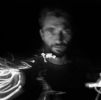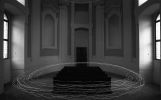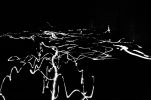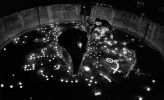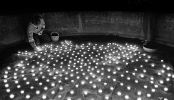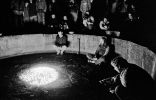"'… in this body, in the upper sixth step, in careful perception and reflections, is a world, the beginning of a world and a path leading to the elimination of suffering,' says the Buddha (Anguttaranikajo). Each sacred building repeats the act of the Creation of the World. Each the same symbolic structure and, like an Axis of the World, each is connected to the spheres of Heaven, Earth and the Underworld. Santini’s cloister in Plasy is a building constructed on a swamp, resting upon oak pillars above a labyrinth of water (traditionally, underground water symbolizes the water of chaos). A foundation stone above the entrance into the underground system bears the inscription: AEDIFICUM SINE AQUA RUET - 'without water the edifice will be in ruin.'
Such buildings represent a cosmos – an order emerging from Chaos, and water is necessary for it to remain standing! The Cistercians sought to revive the original godly order in nature through work and prayer. They explored these relations and created a place for meditation, introspection, the discovery of the Center. The aim of the project is to explore these issues and create a space for reflection, for a return to the self and for the rediscovery of the axis of being."
Igor Hlavinka, August 8th, 1997
"The imaginary circle, divided by an imaginary cross into 4 fields, created space for improvisation for 4 players who reassambled burning candles, each in their field. They acted either entirely arbitrarily or reacted to other teammates, including musicians. The ever-changing light structure of 365 burning candles foscilated between chaos and order. In a random cluster, lines, signs, ornaments, geometric structures appeared and disappeared. Center appeared and faded away.
The performance was based on the cycle of my drawings at the beginning, where the chaos formed around the center in the basic structure of the cross-divided circle. I have also been inspired by the mandalas of Tibetan monks, created from the four world directions or by random structures of thousands of candles lit during All Saints celebration, shining in the dark under a large cross in the middle of the Olšan Cemetery."
Igor Hlavinka, 2018
"'Into the Circle' - light drawing, private performance without spectators, chapel of St. Benedict in Plasy, photo by Daniel Šperl. Walking meditation. I circled around the center like a moth around the lamp. I walked slowly with the candle lit in my hand around the perimeter of St. Benedict's chapel, and a long exposition in the camera recorded its light trace."
Igor Hlavinka, 2018
1. Photography performance in the Saint Benedict Chapel, in collaboration with Daniel Šperl.
2. Light performance at the pool of the prelature yard, in collaboration with Petr Nikl, Pavel Mrkus, Jan Svoboda, Vladimír Vimr, Jiří Melcl, with sound by Irena and Vojtěch Havlovi, Michael Delia, and Brutus (from afar).
Igor Hlavinka (born 1959 in Prague) is a painter who, from 1979 to 1982, studied stage design at the Prague Academy of Performing Arts. In 1986, he graduated from the Academy of Fine Arts in Prague in Landscape and Figural Painting, the studio of František Jiroudek. Eventually, he made landscape painting, drawings, as well as figural and abstract painting (Cycle Characters, Chaos and Order, Stunning Symmetry, Around the Center).
In the 1990s, he participated in the symposium of the Hermit Foundation at the Plasy monastery. In 1997, he initiated and co-organized the international art symposium "Near the Beginning." For several years, he has been working on restoration of wall paintings, and designing and realizing gardens. He has participated in many collective and independent exhibitions, and his work is represented in many private and public collections. Between 1989 and 1992, he was a member of the Tunnel Art Group and, since 1996, has been a member of S. V. U. Mánes. He lives and works in Prague.
